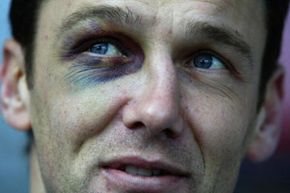Ouch! You weren't looking where you were going and rammed your thigh into the edge of your dining room table. Or, you were biking and moved into a turn too quickly, and took a spill. Or, you were throwing the ball around and instead of it falling into your glove, it hit your arm. Lots of mishaps can result in the formation of a bruise. Although the pain might last for only a couple of minutes, you'll be wearing that ugly bruise as a reminder of your blunder for a while. But what causes your skin to turn back and blue?
Basically, a bruise, or contusion, as it's referred to in the medical world, appears when blood vessels break due to a blow to the skin. Blood leaks out of these vessels resulting in a red, purple or black mark on your skin. Sometimes your skin can become raised when the blood from these vessels leaks into the surrounding tissues. In most healthy individuals, your body eventually will reabsorb the blood, and the bruise will disappear. In general, the harder your bump or blow, the larger your bruise will be, and arms and legs are the most typical areas for bruises.
Advertisement
Aside from smarting a bit and being unattractive reminders klutziness, most bruises are pretty harmless. But there are some serious medical conditions that bruising can indicate. We'll let you know what those conditions are on the next few pages.
So, how do bruises form? Why do they change color? How can you make them go away faster? If you're someone who bruises easily, you're probably aching to learn the answers to these questions -- in addition to that bigger question: Why do I bruise more easily than other people?
Advertisement


